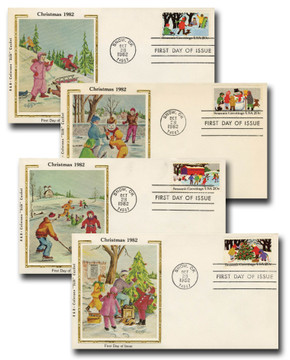
U.S. #2030
1982 20¢ Decorating the Tree
Season's Greetings
Contemporary Christmas
- From the 18th Contemporary Christmas issue
- One of four stamps depicting children enjoying fun winter activities
Stamp Category: Commemorative
Set: Season’s Greetings
Series: Contemporary Christmas
Value: 20¢, first-class rat... more
U.S. #2030
1982 20¢ Decorating the Tree
Season's Greetings
Contemporary Christmas
- From the 18th Contemporary Christmas issue
- One of four stamps depicting children enjoying fun winter activities
Stamp Category: Commemorative
Set: Season’s Greetings
Series: Contemporary Christmas
Value: 20¢, first-class rate
First Day of Issue: October 28, 1982
First Day City: Snow, Oklahoma
Quantity Issued: 197,220,000
Printed by: Bureau of Engraving & Printing
Printing Method: Photogravure
Format: Panes of 50 in sheets of 200
Perforations: 11
Why the stamp was issued: For use on winter and holiday mail.
About the stamp design: The 1982 Seasons Greetings stamps express the popular theme that Christmas is a time for children. Designed by Dolli Tingle, the Christmas Tree stamp pictures four children decorating a tree outside for Christmas.
First Day City: The First Day ceremony for the Season’s Greetings stamps was held at the Recreation Center in Snow, Oklahoma.
Unusual fact about this stamp: Imperforate error stamps have been found.
About the Contemporary Christmas series: The US issued its first Christmas stamp (picturing a wreath and candles) on November 1, 1962, and it was wildly popular. The Post Office printed 350 million stamps, the largest print run for a special stamp up to that time, but still the stamps quickly sold out. The Bureau of Engraving and Printing produced more to satisfy demand and the total number issued was over 860 million by the end of the year.
In 1966, the Post Office started issuing traditional themed Christmas stamps picturing the Madonna and Child and other religious icons. In 1969, they switched back to non-religious Christmas designs with a stamp picturing the painting Winter Sunday in Norway, Maine.
Finally, in 1970, the Post Office decided to permanently split Christmas stamps into two categories to satisfy everyone: Traditional and Contemporary. They issued a block of four stamps picturing Christmas toys along with a stamp picturing a classic painting of the Nativity. The decision to do both proved popular, and the Post Office has continued to issue stamps in both categories ever since.
History the stamp represents: A fully decorated fir tree is one of the universal symbols of Christmas. The very fragrance of spruce, balsam, and cedar conjures up images of piny fragrances and of Christmases past and Christmases yet to come.
It seems like Christmas trees have always been with us, but this is not so. It is believed the practice began with the German-speaking peoples. One legend claims people brought fir trees indoors for the winter solstice after a missionary convinced them that this was a better way to celebrate life rather than sacrificing their youth in the dark forest. Another story claims Martin Luther began the practice.
Although German immigrants adorned their holiday tables with fir trees, the practice did not become fashionable in the United States until German-born Prince Albert, Queen Victoria’s husband, set up the first Christmas tree in Buckingham Palace. New York City’s high society, predominantly Anglo-Saxon, jumped on board. The practice spread through the land and within five decades, Christmas without an evergreen tree was simply not Christmas.










